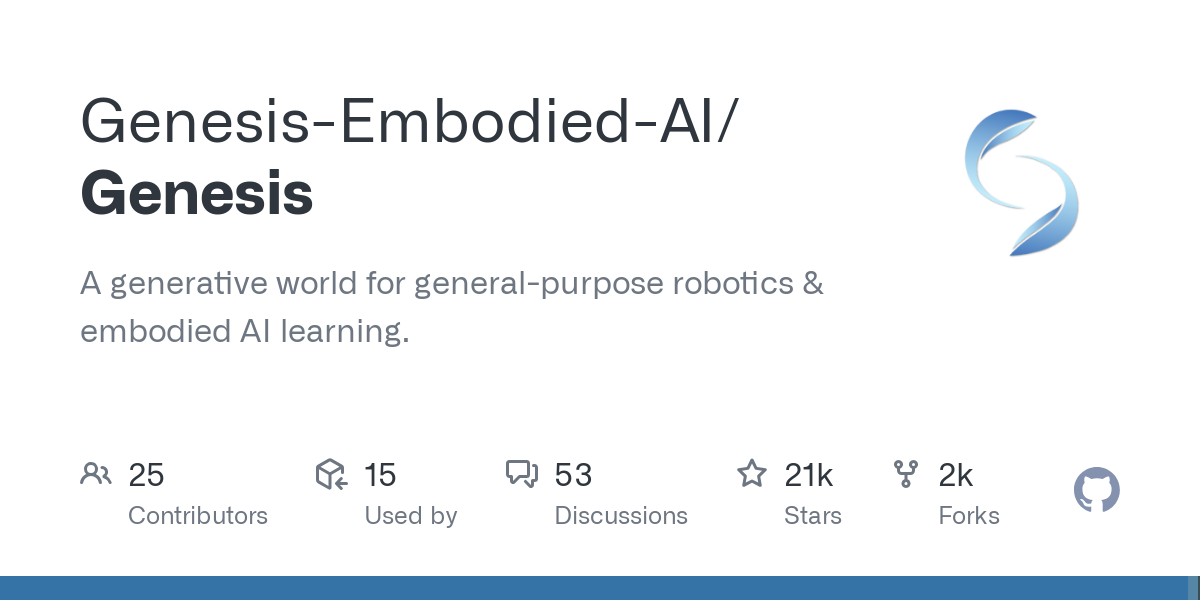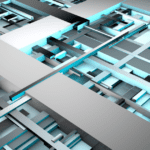Robotics and artificial intelligence are stepping into a new era with Genesis—a groundbreaking platform that seamlessly merges Generative AI with real-world physics simulation. By enabling the creation of dynamic, interactive environments and accelerating training times, Genesis sets a new standard for developing smarter, more adaptable robotic systems. Designed for speed, precision, and usability, this open-source tool is unlocking innovative possibilities for researchers, developers, and industries striving to push the boundaries of automation and AI.
What Makes Genesis Revolutionary?
Genesis represents the next frontier in physics engines, going beyond traditional simulation tools to deliver a platform optimized for advanced robotics and physical AI. Its innovations lie in several key areas:
- Generative AI Integration: Automates the design of virtual environments and robotic training processes.
- Real-Time Speed: Trains robots in seconds, reducing computational bottlenecks.
- Unmatched Versatility: Handles rigid body dynamics, fluid mechanics, soft robotics, and more within a unified framework.
- Open Source Accessibility: Democratizes advanced robotics by providing free access to its robust tools.
The Core Features of Genesis
Generative AI for Automated Robotics Training
Genesis introduces a generative AI agent that simplifies and accelerates robotics development:
- Autonomous Environment Design: Creates detailed, interactive simulations of real-world spaces like homes and industrial settings.
- Task Definition: Suggests practical tasks for robots, such as opening doors, manipulating objects, or navigating through obstacles.
- Reward Systems: Establishes incentives to guide robots toward achieving goals efficiently.
- Policy Automation: Writes robotic policies that dictate movement, interaction, and decision-making, saving developers time.
This end-to-end automation allows robots to be trained with minimal manual intervention while maintaining high accuracy and relevance to real-world scenarios.
Advanced Multi-Physics Simulation
Genesis supports a broad spectrum of physical phenomena:
- Material Modeling: Simulates rigid, soft, and fluid materials, enabling realistic interaction between robots and their environments.
- Soft Robotics Support: Accurately models soft muscle movements and their interactions with rigid structures, crucial for applications in healthcare and search-and-rescue.
- Non-Convex Collision Handling: Tackles complex, irregularly shaped objects like gears or chains with unparalleled precision.
Unparalleled Speed and Scalability
Genesis’s computational architecture leverages modern GPUs for exceptional performance:
- Rapid Training: Robots can learn to walk in 26 seconds using a single NVIDIA RTX 4090.
- Massive Scalability: Simulates 10,000 robotic arms simultaneously in under 2 milliseconds, making it ideal for industrial-scale applications.
- Python Integration: Accessible to developers of all levels, Genesis eliminates steep learning curves associated with other platforms.

Python Integration: Accessibility Meets Power
One of the defining features of Genesis is its Python-based architecture, which combines simplicity with flexibility. Python’s prominence in AI and robotics makes Genesis a seamless choice for developers, researchers, and engineers. Whether you are prototyping a robotic system, running reinforcement learning experiments, or developing complex simulations, Genesis’s Python API empowers you with intuitive and efficient tools.
Key Benefits of Python in Genesis:
- Ease of Use: Genesis uses Python’s human-readable syntax, making it accessible for developers at any skill level.
- Rich Ecosystem: Genesis integrates easily with Python’s vast libraries, such as NumPy for numerical computation, matplotlib for visualization, and TensorFlow/PyTorch for AI workflows.
- Rapid Experimentation: Users can iterate quickly on their simulations without the need for extensive configuration.
- Open-Source Community: Leveraging Python ensures Genesis is backed by a rich, global community for support and collaboration.
Real-World Examples with Python in Genesis
1. Simulating a Robotic Arm for Pick-and-Place Tasks
Create a simulation for a robotic arm, define its material properties, and train it for pick-and-place tasks with only a few lines of Python:
from genesis.simulation import RoboticArm
from genesis.materials import Steel
# Initialize a robotic arm with 6 degrees of freedom
arm = RoboticArm(material=Steel, joint_count=6)
# Define the task
arm.set_task("Pick and Place", target_position=[1.0, 0.5, 0.2])
# Run the simulation
arm.simulate(duration=30)
# Output metrics like accuracy and efficiency
results = arm.get_performance_metrics()
print(f"Task Efficiency: {results['efficiency']}%")This example demonstrates how Genesis’s API makes it effortless to simulate real-world robotic applications.
Train a quadruped robot to navigate a dynamic obstacle course using reinforcement learning, leveraging Python libraries for machine learning and Genesis for realistic physics:
from genesis.simulation import QuadrupedRobot
from rl_library import ReinforcementTrainer
# Initialize a quadruped robot with Genesis
robot = QuadrupedRobot(model="SpotMini")
# Create a dynamic obstacle course
robot.set_environment(obstacles="Dynamic")
# Connect to an RL trainer
trainer = ReinforcementTrainer(robot=robot)
# Train the robot in simulation
trainer.train(episodes=1000)
# Save the trained policy
trainer.save_policy("quadruped_navigation_policy.json")This example shows how Genesis integrates with reinforcement learning libraries to train robots in complex scenarios.
3. Simulating Soft Robotics for Healthcare Applications
Simulate a soft robotic gripper for precision tasks, such as manipulating fragile objects in a surgical environment:
from genesis.simulation import SoftRobot
from genesis.materials import Elastic
# Create a soft robotic gripper
gripper = SoftRobot(material=Elastic, structure="Gripper")
# Define interaction parameters
gripper.set_task("Manipulate Object", object="Glass Vial", pressure_limit=10)
# Run the simulation
gripper.simulate(duration=20)
# Analyze grip stability and precision
metrics = gripper.get_task_metrics()
print(f"Grip Stability: {metrics['stability']}%, Precision: {metrics['precision']}%")This example highlights Genesis’s capability to simulate soft robotics, which is critical for industries like healthcare.
4. Designing and Testing a Humanoid Robot
Genesis can help you design and test a humanoid robot for complex tasks like navigating urban environments:
from genesis.simulation import HumanoidRobot
# Initialize a humanoid robot
humanoid = HumanoidRobot(name="Atlas", height=1.8)
# Add environmental constraints
humanoid.set_environment("Urban", weather="Rainy", terrain="Uneven")
# Simulate navigation
humanoid.simulate(duration=60, task="Navigate to Point", target=[10, 0])
# Review task performance
performance = humanoid.get_performance_report()
print(f"Navigation Success Rate: {performance['success_rate']}%")This example underscores Genesis’s ability to simulate real-world conditions for humanoid robots.
Why Python Matters in Genesis
The choice of Python as Genesis’s backbone is more than a convenience—it’s a strategic enabler for innovation. Its flexibility allows developers to focus on solving real-world problems without getting bogged down by technical complexities. Python ensures that Genesis is accessible to both experts and newcomers, fostering a thriving community of robotics and AI enthusiasts.
These examples showcase how Python in Genesis empowers users to tackle diverse challenges across industries, from healthcare to manufacturing, paving the way for groundbreaking advancements in robotics and AI.
Why Genesis is a Game-Changer
Addressing Data Collection Challenges
One of the most significant hurdles in robotics development is collecting sufficient real-world data. Genesis overcomes this by creating highly accurate virtual environments that mimic real-world physics. This allows developers to:
- Generate synthetic data for machine learning models.
- Conduct extensive testing without the risks and costs associated with physical prototypes.
- Scale training efforts globally with minimal resources.
Soft Robotics and Beyond
Soft robotics, a notoriously difficult field to simulate, is one of Genesis’s standout features. It offers:
- Realistic modeling of soft muscle interactions and deformable structures.
- Tools to design and test soft robotic systems for industries like healthcare, where precision and adaptability are critical.
Efficiency in Robotic Policy Development
Genesis introduces a groundbreaking approach to policy writing:
- Robots not only learn tasks but adapt strategies over time to optimize performance.
- Developers can simulate edge cases and failure modes, ensuring robust and resilient designs.
Real-World Applications of Genesis
Robotics and AI Development
- Prototype Testing: Develop and iterate on robotic designs in a fraction of the time required for physical prototyping.
- Reinforcement Learning: Train AI agents to interact with complex environments, from industrial warehouses to medical facilities.
- Synthetic Data Generation: Create vast datasets to train machine learning models for robotics and AI.
Industrial Impact
- Manufacturing: Companies like AutoTech Industries are leveraging Genesis to optimize production lines, reducing setup times by 40% and material waste by 25%.
- Game Development: Genesis’s realistic collision handling and material modeling are revolutionizing physics engines for gaming applications.
Research and Academia
Genesis facilitates groundbreaking studies in robotics and AI by providing an open-source platform that encourages global collaboration.
Key Differentiators of Genesis
Genesis sets itself apart from competitors like NVIDIA’s Isaac Sim and Mujoco in several ways:
- Speed: Training and simulations are 10-80x faster, enabling rapid experimentation.
- Comprehensive Physics: Supports everything from fluid dynamics to soft robotics in a single platform.
- Scalability: Handles large-scale simulations effortlessly, making it ideal for industrial and academic research.
Getting Started with Genesis
- Download the SDK:
- Access Genesis from the official repository.
- Follow platform-specific setup guides for quick installation.
- Explore Learning Resources:
- Comprehensive documentation and tutorials cater to all skill levels.
- Join webinars and community forums for expert insights.
- Integrate and Experiment:
- Upload your own models, designs, and environments to start exploring Genesis’s capabilities.
The Future of Robotics with Genesis
The roadmap for Genesis includes exciting advancements:
- Cloud-Based Simulations: Distributed computing for large-scale projects.
- Enhanced Sensor Integration: Realistic modeling of LIDAR, radar, and optical sensors.
- Real-Time Hardware Integration: Improved support for hardware-in-the-loop (HIL) testing.
- AI Framework Compatibility: Seamless integration with TensorFlow, PyTorch, and other machine learning tools.
Conclusion
Genesis is more than a physics engine—it’s a transformative platform redefining how robotics and AI interact with the physical world. With its unique combination of speed, versatility, and accessibility, Genesis empowers developers, researchers, and industries to achieve breakthroughs faster than ever before. Whether you’re a robotics enthusiast, an AI researcher, or an industry leader, Genesis provides the tools you need to innovate.





Leave a Reply